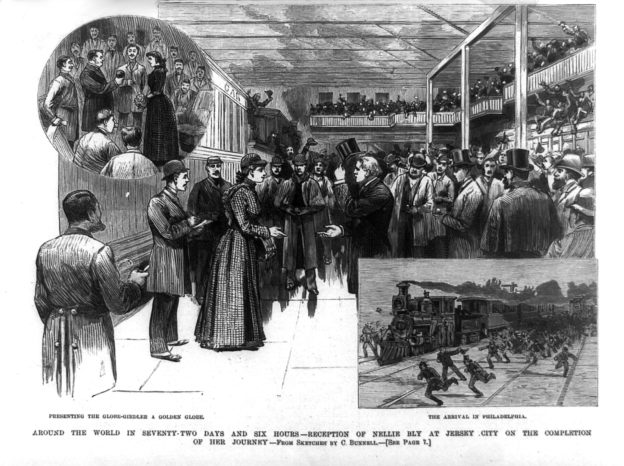Working from home during the COVID-19 pandemic has allowed me the opportunity to explore the AAS catalog in fun new ways. Inspired by my family’s board games, which have been stacked in the living room since our transition to remote work, one recent search led to our games collection. While many of the games piqued my interest, the Game of Round the World with Nellie Bly fascinated me more than the others. I recognized Bly’s name from history lessons long ago, but I could only recall a handful of details about her life as a journalist. The onset of cabin fever and my longing to travel beyond the front porch prompted me to learn more about the famous Nellie Bly, who inspired the game, and her adventures across the globe.
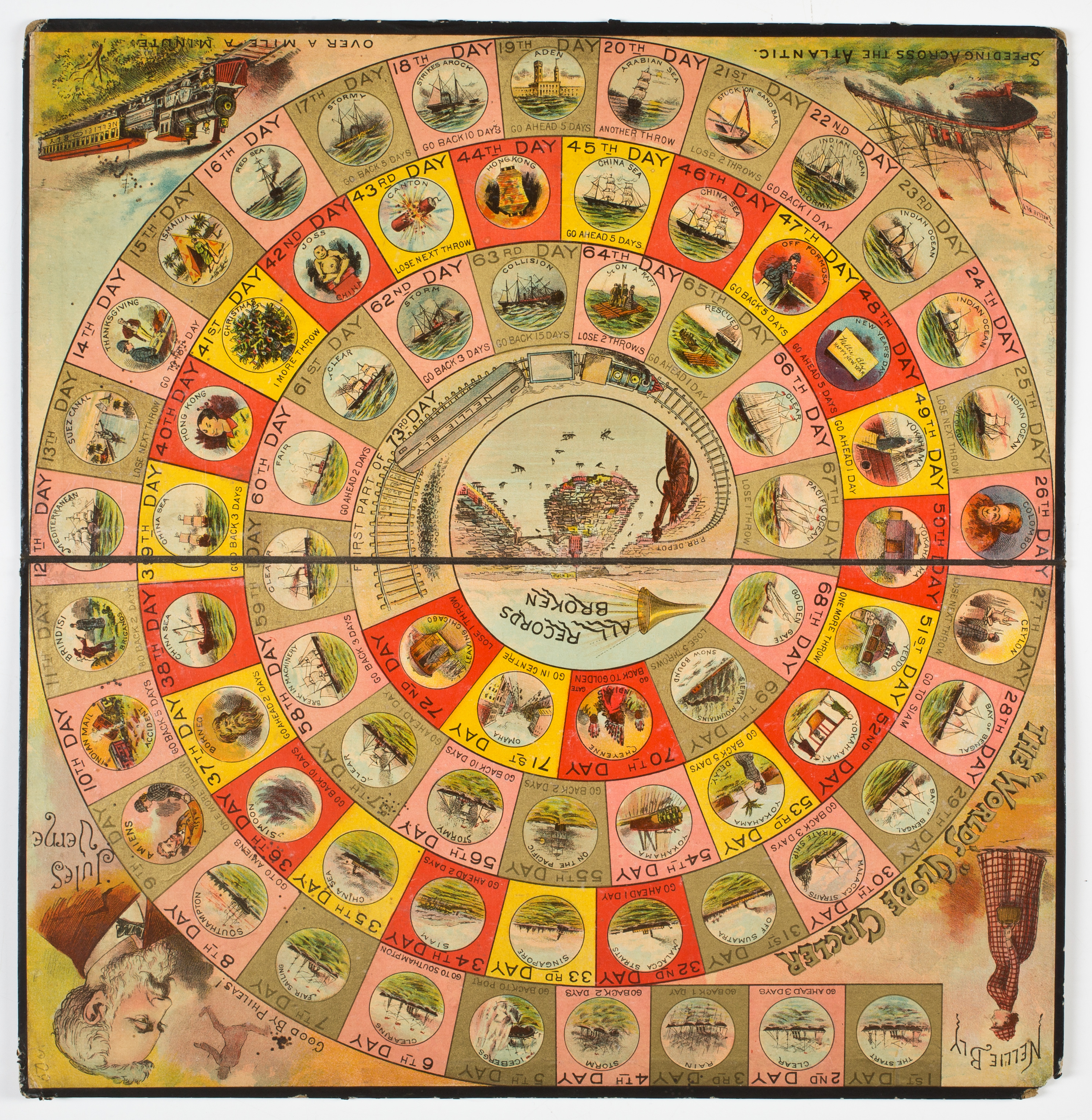 Nellie Bly was the pseudonym of Elizabeth Cochran (1864-1922), a newspaper journalist who became somewhat of a celebrity during the late nineteenth century after writing various investigative reports for the New York World. Her name became even more recognizable when she took her trip around the world in 1889.
Nellie Bly was the pseudonym of Elizabeth Cochran (1864-1922), a newspaper journalist who became somewhat of a celebrity during the late nineteenth century after writing various investigative reports for the New York World. Her name became even more recognizable when she took her trip around the world in 1889.
Early in her career, people took note of Bly and her writing. Around the age of 16, Bly became upset after reading an article in the Pittsburgh Dispatch. The article claimed that women were only good for having children and taking care of the home. Bly showed her distaste for the article by writing an anonymous letter to the editor of the Dispatch. Much to Bly’s surprise, the editor published a notice that not only asked the anonymous writer to come forward, but also offered a job writing at the newspaper.
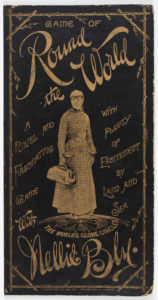
Bly accepted the position and adopted the pseudonym suggested by her editor. But Bly quickly tired of her position after continually being asked to write about gardening, cleaning, and other domestic activities for the women’s pages. Unafraid of traveling to new places alone, Bly decided to leave Pittsburgh in 1886 for New York City in hopes of finding better writing opportunities.
After months of unsuccessfully searching for work, Bly managed to talk her way into the offices of Joseph Pulitzer’s New York World. As a reporter, she often placed herself in risky situations to get a good story. For one assignment, Bly feigned insanity to get into the women’s asylum on Blackwell’s Island to reveal the abuse and neglect the patients experienced. Her reports brought the public’s attention to the mistreatment at the asylum and led to major reforms.
In 1889, Bly challenged herself to make a trip around the world in less than 80 days. She was determined to beat the time of Phileas Fogg, the main character in Jules Verne’s 1873 novel, Around the World in Eighty Days. When Bly first proposed the idea to her editor at the New York World, he doubted her. He believed a man would be a better fit for the trip since he would not require a chaperone and would not be prone to bring loads of luggage. With her determined spirit, Bly somehow convinced her editor that she was capable of completing this assignment and began preparing for the trip. From the start, she mocked her editor by packing everything she needed in just one bag! Bly and her single bag can be found on the front of Game of Round the World with Nellie Bly and in a preliminary print for the game.
Bly’s trip officially began on November 14 when she boarded the Augusta Victoria steamship in New Jersey and headed across the Atlantic Ocean towards Europe. Just as the board game suggests, bad weather made some of Bly’s trip across the sea a rough one, and she even became seasick.
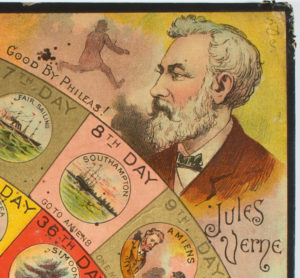
One week later, Bly arrived in England and met a correspondent from the New York World. The man explained that Jules Verne, whose portrait is depicted on a corner of the game board, and his wife wanted Bly to visit them at their home in Amiens, France. Although this unexpected excursion added time to Bly’s journey, it was an offer she could not refuse. The couple welcomed Bly into their home with open arms and were excited to hear about her travel plans. Verne even brought Bly into his study and showed her a map of Phileas Fogg’s route that he had marked out himself.
After a short but delightful visit, Bly continued on her journey. Large portions of the trip were spent on steamships and trains. While her schedule didn’t allow her to stay in one place for very long, at each stop Bly tried to take a walk and meet some of the local people. Bly’s voyage continued into Egypt, where she visited cities such as Port Said, Ismailia, and Suez. Whenever possible, she sent written reports of her observations back to the New York World by telegraph and by ship. During the interims between her stories, her editors published articles about the places she would be visiting next to keep readers interested. Stopovers included Yemen, Sri Lanka, Malaysia, and Singapore.
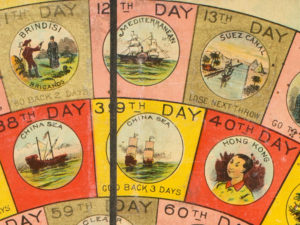
In Hong Kong, Bly discovered that she wasn’t the only woman racing around the world. Cosmopolitan magazine had recently sent out journalist Elizabeth Bisland on a similar trip with the hopes that she could beat Bly’s time. Bly wasn’t flustered by the competition and stayed focused on her own trip and goals. While Bisland made her way along a similar route, Bly continued forward to her next stop Yokohama, Japan, where she explored the city’s streets and enjoyed watching families fly kites outside their homes. Again, Bly couldn’t get too comfortable; she was about to enter the last leg of the expedition.
After nearly two weeks at sea, Bly arrived in San Francisco on January 21 (two days behind schedule) and raced back to New Jersey. On January 25, 1890, an enormous crowd of people welcomed Bly home from her trip around the world. She completed the journey in 72 days, 6 hours, and 11 minutes, beating Bisland and Verne’s protagonist.
As much fun as it is to play (and to win) the game, I’m sure it’s nothing when compared to the excitement and pride that Bly must have felt that day. She had accomplished her goal and proved to the world that women could do much more than just household duties.
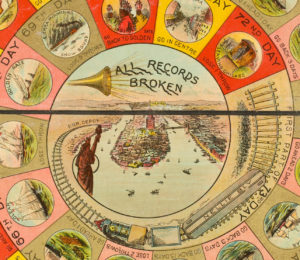
The McLoughlin Brothers publishing firm distributed Game of Round the World with Nellie Bly in 1890 during the height of Bly’s fame. According to the firm’s product catalogs from the period, basic versions of the game sold for 30 and 50 cents and an enlarged edition cost $1.00. Although the game was advertised alongside children’s books and toys, it was described as “pleasant amusement for old or young.” Two to four players used spinners to determine moves and tried to beat opponents by circumnavigating the board the fastest. As players moved small wooden pieces around the board, they got a sense of the places Bly went and the experiences she had during her trip. In addition to the McLoughlin Brothers copy, a paper cut-out version of the game appeared in a January 1890 issue of the New York World when Bly was still traveling. It is no wonder that the McLoughlin Brothers company sold this game based on Bly’s adventures. In an attempt to make money, advertisers attached Bly’s name to a number of items and went as far as naming a racehorse and train after her.
Bly was an inspiration back in 1890, and she continues to be one today. Over a century later, Bly’s ambitious trip reminds me that life can be as entertaining as a board game if you take risks and step outside of your comfort zone. Of course, I couldn’t venture very far at the time this was written, but I did have access to countless pieces of history through the AAS catalog. Little did I know that one click into the catalog would take me on a journey through Bly’s life and on a trip around the world with her.
Further Reading
Around the World in 72 Days: The Audacious Adventures of Nelly Bly. Christine Lesiak and Mel Bucklin. WGBH Boston Video, 2006. https://www.pbs.org/wgbh/americanexperience/films/world/#film_description
Bly, Nellie, Elizabeth Bisland, and Matthew Goodman. The Race Around the World. Lakeside Press, 2015. Housed at the American Antiquarian Society.

